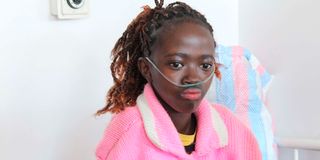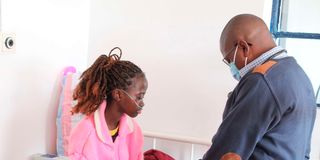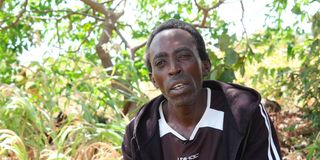A little girl, her oxygen tank and electricity woes that won't let her go home

Missy Kananu, 13, at Meru Teaching and Referral Hospital, where she has lived for two years.
What you need to know:
- Missy Kananu, who is battling a chronic lung disease, is stuck in hospital because her village has no electricity to charge batteries for her air storage tank.
- A complete solution would be lung transplant, but the procedure is not available in the country.
Missy Kananu, 13, sits at a corner bed right at the entrance of a paediatric ward at Meru Teaching and Referral Hospital.
There are two other patients, but she is the only with a nasal cannula –a thin clear tube affixed at her nose and around her head via the ears to a portable oxygen concentrator. It helps her to breathe without straining.
Every breath she takes, the machine that has now become part of her life produces a sound similar to one that occurs when one exhales loudly.
On the front side of her bed is a portable gunny bag which has her belongings. She also has a notebook and two versions of Gideon's New Testament Bible –one in Swahili, the other in English.
For two years, sickness has forced Kananu to be out of her parents’ home. In those two years, she has been at Kenyatta National Hospital and Meru Teaching and Referral Hospital because she can’t breathe without a supplementary oxygen machine.
Her home, which is in Kithwene sub-location, is about two hours away from Meru town. Their village has no electricity and her family cannot afford solar installation.
Kananu has not seen her siblings for two years. She has not gone to school for two years. She has not bonded with her friends for two years. She has been robbed of her childhood for two years, and counting…

Dr Ezekiel Machira, a paediatrician at Meru Teaching and Referral Hospital, checks on Missy Kananu at the hospital ward.
Her life now revolves around the four walls of a hospital ward.
As we drive to her home in Kithwene, which translates to anthills in the Meru tribe, civilisation ends when we veer off the main road along the Meru-Maua highway.
There are many hills visible on the way to their home, including the Nyambene Hills, an important catchment area for Tana and Ewaso Nyiro Rivers.
The road is rocky. So rocky that we get a puncture from the sharp stones. As we move closer to Kananu’s home, there is barely any road, but just pathways created by villagers. We hit a dead end when we come across what used to be a road but is now a deep gulley which Kananu’s dad,–Isaac Kithinji, tells us that it is one of the El Nino aftermaths.
When we get to her parents’ home, her mother welcomes us.
“How is my daughter?” She asks.
Both parents have not seen Kananu in a while.
“She is okay, she was smiling the whole time, but she could not speak to us,” I tell her, showing her Kananu’s beautiful photos that I had taken using my phone.
“I miss her a lot. Look, she has even braided her hair,” says the mother. I smile back, giving her an assurance that despite her daughter's condition, Kananu was okay.
But how did Kananu get here?
She was 11 and in Grade three. In July 2022, her father tells us that the first symptom they noticed was fatigue.
“She would come home from school feeling so tired. I first took her to a local private hospital and didn’t see any signs of recovery,” says Isaac.

Missy Kananu’s father Isaac Kithinji. He appeals to the government to help with power connection in their village.
He took her to Meru Teaching and Referral Hospital, where she was immediately put on supplemental oxygen. A month after admission, Kananu was referred to Kenyatta National Hospital (KNH), where she stayed for 10 months.
When she became a bit stable, she was brought back to Meru but she could not go home because she had become oxygen-dependent.
“We don’t have electricity here, so, to this day, my child is still in hospital because we have nowhere to frequently charge her oxygen machine batteries,” Isaac says.
Dr Ezekiel Machira, a paediatrician at Meru Teaching and Referral Hospital, has taken care of Kananu since the day she was brought to the hospital two years ago.
He tells us that when the girl came to the hospital, she had difficulty in breathing, a persistent cough, night sweats and she had lost weight.
“After the initial investigation for about two weeks, we were able to start the child on anti-tuberculosis therapy. However, even after starting her on anti-TBs, she continued requiring oxygen,” he says.
“Anytime you would switch them off oxygen, her oxygen levels would drastically come down. They would come down to 50-60 per cent,” he adds.
With the supplemental oxygen, Kananu’s oxygen levels were above 90 per cent, which is the recommended level.
That is when Dr Macharia and team made a decision to refer her to KNH in Nairobi, to see a chest specialist - a paediatric pulmonologist.
From the follow-up and treatment at KNH, the child was confirmed to have chronic lung disease, which is interstitial lung disease.
Dr Machira explains that it means her lungs have substantially been destroyed by the infection and as a result, the normal surface of the exchange mechanism for oxygen has been disrupted. Unfortunately, that is something that is not repairable.
“The only thing that can be a complete solution would be a lung transplant. Otherwise, the lung that she has has undergone substantial destruction, and that's why she has to be given supplemental oxygen 24/7,” says Dr Machira.
The hospital raised Kananu’s case and got some help from the Center for Public Health Development, who after assessing her needs offered to give her a portable oxygen concentrator.
“This portable oxygen concentrator is battery-driven, and the battery is rechargeable through mains electricity,” says Dr Machira.
The battery, when fully charged, lasts for about 12 hours. This has aided her breathing for the last eight months. The concentrator has two batteries and when one is charging, the other can be in use, but the family has not found a reliable place to charge.
“We had tried to negotiate with a nearby school and see whether they could do that, but there were a few issues, and, the practicality of how the child would be moving from home to school and the overnight stay, you would require an assurance that both batteries would last the entire night,” explains Dr Machira.
Let's talk a bit about this condition. What causes it?
There are multiple causes of chronic lung disease. For this particular case, Dr Machira explains that their assessment shows the underlying problem could have been the pulmonary tuberculosis that the child was suffering from.
“The diagnosis came in a bit late - a situation where the destruction of the lung tissues was already overwhelming,” he says.
Despite Kananu going through the entire six weeks of treatment of pulmonary TB and completing it, Dr Machira says the destruction had already been done and it was difficult to correct that.
This, however, is not the only cause of chronic lung disease.
“It could be autoimmune; this is a situation where your body is producing antibodies fighting against its own cells. But the ultimate thing is that the lung tissue is overwhelmingly destroyed to the point that it has lost its normal exchange mechanism function,” he explains.
How else does this situation manifest?
Sometimes, babies born prematurely can get chronic lung disease especially when their lungs are not fully developed.
Dr Machira explains that there are some cells that help produce something we call surfactant; it is what helps when you breathe out. Every time you breathe out, a surfactant helps your lungs not to collapse.
It behaves like a balloon, once it is filled with air, it serves its purpose, but when the air is let out, it collapses.
“A surfactant prevents this from happening. It keeps the small air sacs, what we call the alveoli, in the lungs open. So babies who are born with this kind of condition have no adequate surfactant because the cells that make this surfactant are not mature,” he explains.
As a result, these babies would be born with difficulties in breathing.
“Every time they breathe out, a good percentage of their alveoli would collapse. And when they collapse, it requires a lot of effort in the next cycle of breathing, breathing in to now open those alveoli or those air sacs,” he adds.
When that is the case, there is increased work of breathing. And over time, more and more of those air sacs are getting collapsed, and therefore arehard to open up.
And as a result, they now have a reduced surface area, of those air exchange surfaces in the alveoli or in the air sacs.
“In very specific terms for that one, for newborns, we call it bronchopulmonary dysplasia. But it's the same kind of chronic lung disease like what we are talking about here. So they would get dependent on oxygen,” he explains.
How does weight loss come about when one has chronic lung disease?
We require oxygen for metabolism, the normal day activity. If you are making any movement, you burn calories and use up your oxygen.
Dr Machira explains that when you are doing this burning in the absence of enough oxygen, you consume a lot of substrate or the food content in order to produce energy.
“In a situation where you have limited oxygen saturation, you consume more to produce a similar amount of energy. So, that's why you find their weight is either deteriorating or they can't gain weight,” says Dr Machira.
How has Kananu been while in hospital?
From time to time, Kananu, just like any other person, falls ill while in hospital but doctors contain it in good time.
“She can have upper respiratory infections issues and abdominal pain. Sometimes she gets diarrhoea and vomits,” says Dr Machira.
Kananu is susceptible to pulmonary hypertension; meaning that the pressures in her lungs can go up anytime.
This is why in addition to the oxygen that she’s getting, she is also on constant treatment that will help the lungs in terms of reducing the lung pressures.
Dr Macharia explains that when the lung is stiff, the stiffness goes to the vessels in the lungs. This results in the pressures in the lungs being high, which ends up overworking the heart.
“If you have a condition that is destroying your lungs, it's likely to raise those pressures. So this child has also been on that treatment for all that time to try and control pressure in the lungs,” he says.
She has also been on preventive therapy, which serves as a precaution to other infections that are likely to cause more damage to the lung. Kananu is given antibiotics called azithromycin on a weekly basis.
“This is part of the recommendations that were initiated by the chest specialist,” says Dr Machira.
The only solution to Kananu so far is supplemental oxygen, but there is one more option; a lung transplant.
“We are now dealing with supportive care for this lung. We are not healing. We are giving supportive care to the lung because it has already been destroyed,” says Dr Machira.
Kenya does not offer lung transplant, should the family take it up, and it would call for a lot of financial burden. On top of that, Kananu would require a matching donor.
“There must be some testing done to confirm that this lung is actually compatible with it; otherwise they'll face rejection,” explains Dr Machira.
Isaac, Kananu’s father, says that over time, it has become difficult to even see her daughter because of lack of money.
“Previously when I had some money to visit, I would go often. Then I started going after a week, and then two. Now it can go for more than a month without seeing my daughter,” says Isaac.
“You know, when you have a sick child, all you care about is her. I used to do menial jobs, mostly as a mason and could stay away from my family for days. I can’t do that now. I think about my daughter first,” he adds.
Isaac appeals to the government to help with power connection in their village. In the two years that Kananu has been away, her siblings keep asking where she went to.
“They just want to see their sister. I can’t go with them to the hospital because I can’t afford that and children are not allowed in wards,” says Isaac.
“When your child is away, there is a distraught feeling. I love my child and I feel so bad that she is not here with us.
“My child loves reading. When I visit her at the hospital, she keeps telling me that she needs to get out and go to school. I assure her that one day she will be back,” he adds.
Isaac tells Healthy Nation that on both sides from her homestead, electricity is about two kilometres away, which is difficult for him to get a connection since he can’t afford that.
“We keep telling our representatives about the issues here, they promise to help, but we have never seen any action taken especially when it comes to power connections.
“It’s the governor that we see most of the time, rarely the MP, but even when she goes back we don’t hear from her,” he adds.
Nurse Doreen Gatwiri, whom we found talking to Kananu when we visited the hospital, says that the little girl has become her best friend.
“She is my daughter’s age mate, and I have taken care of her since she came here,” she says.
She tells us that Kananu’s routine starts quite early in the morning, where she first takes a shower and then takes breakfast.
You may wonder if she detaches the oxygen concentrator when she is showering. She does not. Even when going to the washroom, while sleeping, technically all the time –she is always on oxygen.
“She cannot play like other children because she has to have her portable oxygen. Sometimes she becomes emotional and starts crying asking when she can go back to school,” says Doreen.
When she gets lonely and starts crying, the impact is that she develops hyperacidity.
“Her immunity is very low, so she is susceptible to other infections,” says Doreen.
The nurse acknowledges that every day, Kananu shows how much she misses her parents, who unfortunately cannot see her until they get fare and that may go up to a month.
“She is a school going child, she needs to be with her parents, getting all the love, if she gets a well-wisher who can help her home get electricity, it will be so good,” says Doreen.






